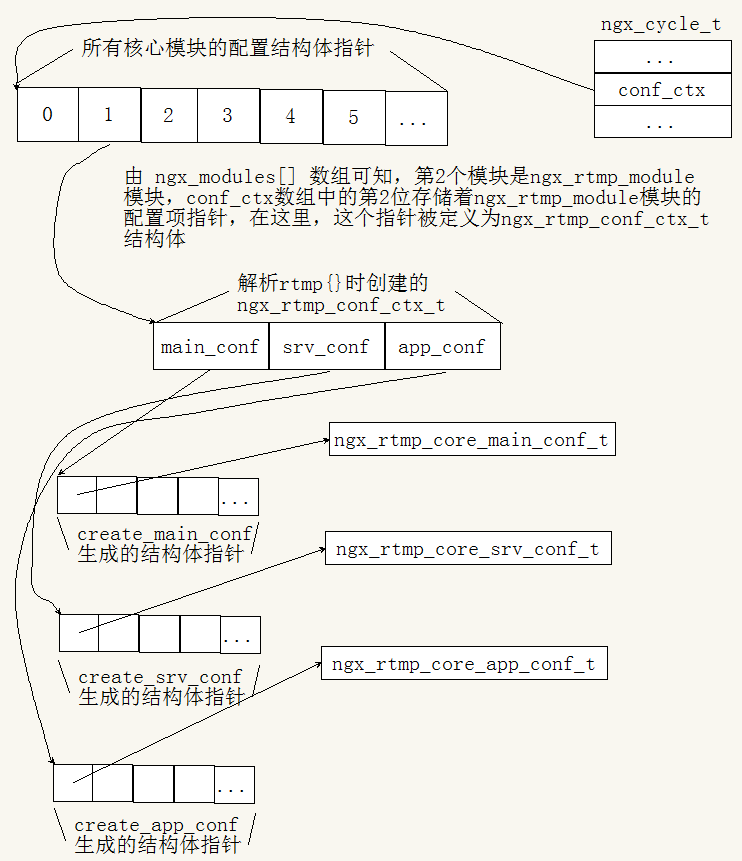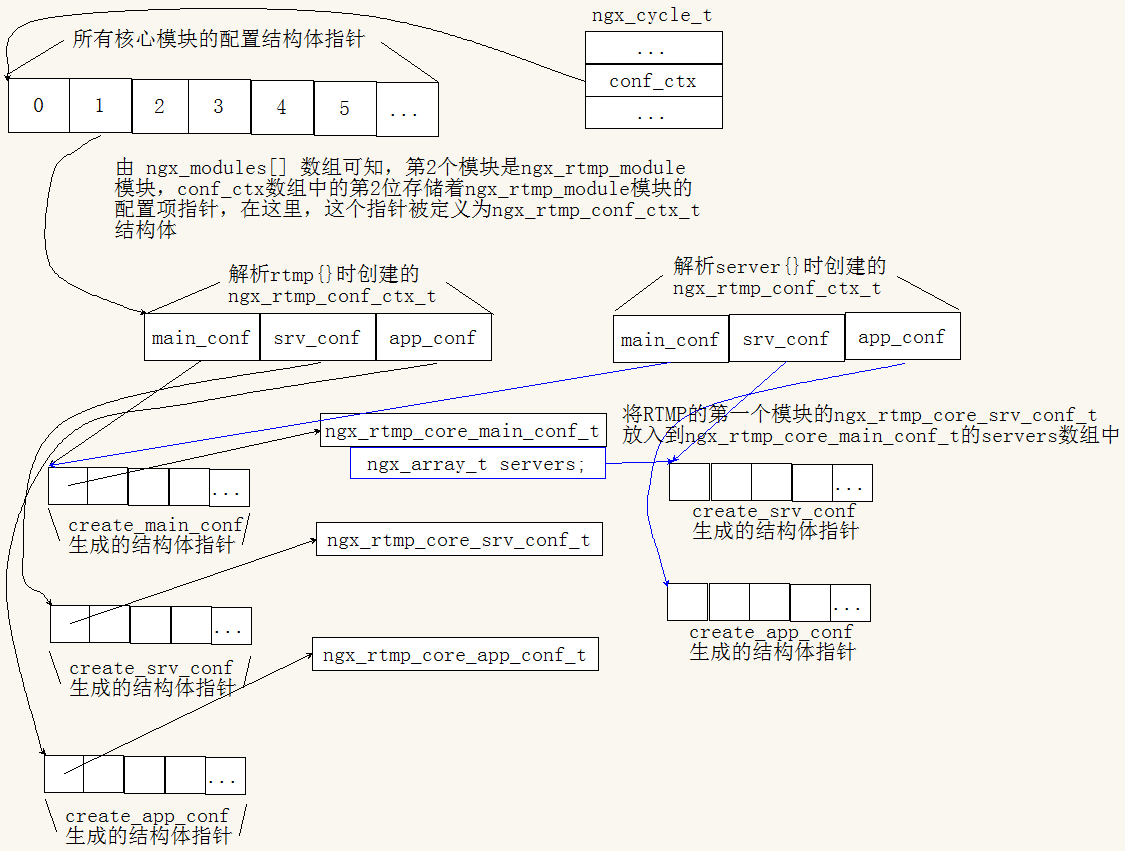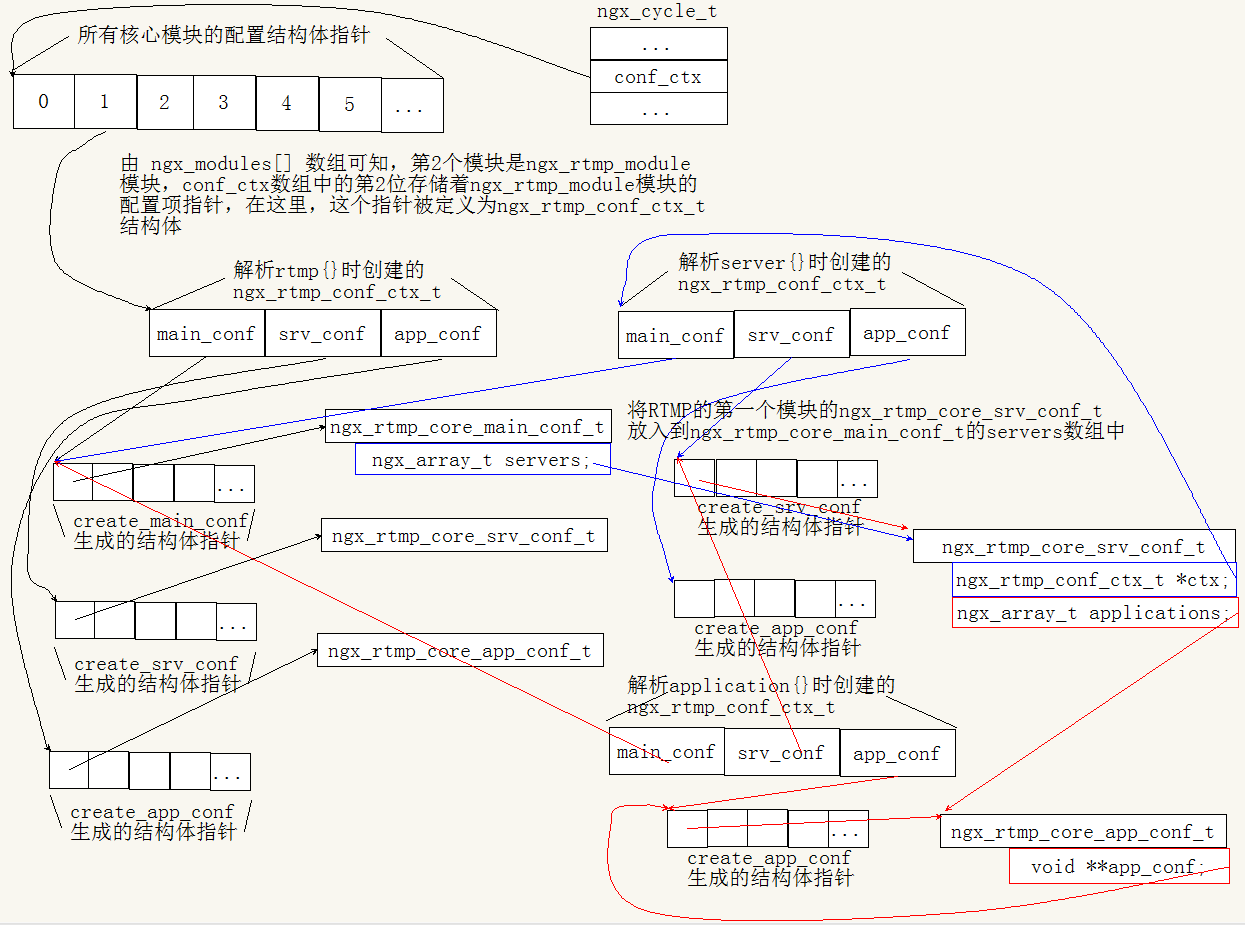1. 概述
Nginx-rtmp 对 rtmp{...} 内的配置项划分了几个级别:
- 直接隶属于 rtmp{} 块内的配置项称为 main 配置项。
- 直接隶属于 server{} 块内的配置项称为 srv 配置项。
- 直接隶属于 application{} 块内的配置项称为 app 配置项。
直接隶属于 record{} 块内的配置项称为 rec 配置项。
#define NGX_RTMP_MAIN_CONF 0x02000000 #define NGX_RTMP_SRV_CONF 0x04000000 #define NGX_RTMP_APP_CONF 0x08000000 #define NGX_RTMP_REC_CONF 0x10000000
对于每一个 RTMP 模块,都必须实现 ngx_rtmp_module_t 接口。
typedef struct {
/* 在解析 rtmp{...} 内的配置项前回调 */
ngx_int_t (*preconfiguration)(ngx_conf_t *cf);
/* 解析完 rtmp{...} 内的所有配置项后回调 */
ngx_int_t (*postconfiguration)(ngx_conf_t *cf);
/* 创建用于存储 RTMP 全局配置项的结构体,该结构体中的成员将保存直属于 rtmp{} 块的配置项参数 */
void *(*create_main_conf)(ngx_conf_t *cf);
/* 解析完 main 配置项后回调 */
char *(*init_main_conf)(ngx_conf_t *cf, void *conf);
/* 创建用于存储可同时出现在 main、srv 级别配置项的结构体,该结构体中
* 的成员与 server 配置是相关联的 */
void *(*create_srv_conf)(ngx_conf_t *cf);
/* create_srv_conf 产生的结构体所要解析的配置项,可能同时出现在 main、srv 级别中,merge_srv_conf
* 方法可以把出现在 main 级别中的配置项合并到 srv 级别配置项中 */
char *(*merge_srv_conf)(ngx_conf_t *cf, void *prev,
void *conf);
/* 创建用于存储可同时出现在 main、srv、app 级别配置项的结构体,
* 该结构体中的成员与 application 配置是相关联的 */
void *(*create_app_conf)(ngx_conf_t *cf);
/* create_app_conf 产生的结构体所要解析的配置项,可能同时出现在 main、srv、app 级别中,
* merge_app_conf 方法可以把分别出现在 main、srv 级别的配置项值合并到 app 级别的配置项中 */
char *(*merge_app_conf)(ngx_conf_t *cf, void *prev,
void *conf);
} ngx_rtmp_module_t;ngx_rtmp_module_t 完全是围绕着配置项来进行的,每一个 RTMP 模块都将根据 main、srv、app 这些不同级别的配置项来
决定自己的行为。
2. 管理 RTMP 的配置项
在处理 rtmp{} 块内的 main 级别配置项时,对每一个 RTMP 模块来说,都会调用 create_main_conf、create_srv_cof、
create_app_conf 方法建立 3 个结构体,分别用于存储 RTMP 全局配置项、server 配置项、application 配置项。问:
rtmp{} 内的配置项本来就是 main 级别的,有了 create_main_conf 生成的结构体已经足够保存全局配置项参数了,为什么
还需要调用 create_srv_conf、create_app_conf 方法建立结构体呢?这是为了把同时出现在 rtmp{}、server{}、
application{} 内的相同配置项进行合并而做的准备。
对于 server{} 块内的配置项的处理,需要调用每个 RTMP 模块的 create_srv_conf 方法、create_app_conf 方法建立两个
结构体,分别用于存储 server、application 相关的配置项,其中 create_app_conf 产生的结构体仅用于合并 application
相关的配置项。
对于 application 块内的配置项则只需要调用每个 RTMP 模块的 create_app_conf 方法建立 1 个结构体即可。
ngx_rtmp_conf_ctx_t
typedef struct {
/* 指向一个指针数组,数组中的每个成员都是由所有 RTMP 模块的 create_main_conf 方法创建的
* 存放全局配置项的结构体,它们存放着解析直属于 rtmp{} 块内的 main 级别的配置项参数 */
void **main_conf;
/* 指向一个指针数组,数组中的每个成员都是由所有 RTMP 模块的 create_srv_conf 方法创建的与
* server 相关的结构体,它们或存放 main 级别配置项,或存放 srv 级别配置项,这与当前的
* ngx_rtmp_conf_ctx_t 是在解析 rtmp{} 或者 server{} 块时创建的有关 */
void **srv_conf;
/* 指向一个指针数组,数组中的每个成员都是由所有 RTMP 模块的 create_app_conf 方法创建的
* application 相关的结构体,它们可能存放着 main、srv、app 级别的配置项,这与当前的
* ngx_rtmp_conf_ctx_t 是在解析 rtmp{}、server{} 或者 application{} 块时创建的有关 */
void **app_conf;
} ngx_rtmp_conf_ctx_t;2.1 与配置项管理相关的两个模块
2.1.1 ngx_rtmp_module
ngx_rtmp_module 模块是 RTMP 的核心模块,定义了新的模块类型 NGX_RTMP_MODULE。这样的 RTMP 模块对于 ctx 上下文
使用了不同于核心模块、事件模块的新接口 ngx_rtmp_module_t。
2.1.1.1 感兴趣的配置项
static ngx_command_t ngx_rtmp_commands[] = {
{ ngx_string("rtmp"),
NGX_MAIN_CONF|NGX_CONF_BLOCK|NGX_CONF_NOARGS,
ngx_rtmp_block,
0,
0,
NULL },
ngx_null_command
};可见,ngx_rtmp_module 核心模块仅是当 nginx.conf 中配置了 rtmp{} 块时指定了 ngx_rtmp_block 方法去解析。
2.1.1.2 上下文结构体
static ngx_core_module_t ngx_rtmp_module_ctx = {
ngx_string("rtmp"),
NULL,
NULL
};这里仅定义了该核心模块的名字。
2.1.1.3 模块的定义
ngx_module_t ngx_rtmp_module = {
NGX_MODULE_V1,
&ngx_rtmp_module_ctx, /* module context */
ngx_rtmp_commands, /* module directives */
NGX_CORE_MODULE, /* module type */
NULL, /* init master */
NULL, /* init module */
ngx_rtmp_init_process, /* init process */
NULL, /* init thread */
NULL, /* exit thread */
NULL, /* exit process */
NULL, /* exit master */
NGX_MODULE_V1_PADDING
};该结构体中仅实现了 init process 方法,该方法也仅是初始化了一个 ngx_rtmp_init_queue 的双向链表。
static ngx_int_t ngx_rtmp_init_process(ngx_cycle_t *cycle)
{
#if (nginx_version >= 1007005)
ngx_queue_init(&ngx_rtmp_init_queue);
#endif
return NGX_OK;
}2.1.2 ngx_rtmp_core_module
ngx_rtmp_core_module 模块是所有 RTMP 模块中的第一个 RTMP 模块,即它的 ctx_index 为 0。RTMP 中主要的
配置块是在该模块中进行解析的,如 server{}、application{} 等。
2.1.2.1 感兴趣的配置项
static ngx_command_t ngx_rtmp_core_commands[] = {
/* 对应 server{},代表一个虚拟主机 */
{ ngx_string("server"),
NGX_RTMP_MAIN_CONF|NGX_CONF_BLOCK|NGX_CONF_NOARGS,
ngx_rtmp_core_server,
0,
0,
NULL },
/* 需要监听的IP地址或端口 */
{ ngx_string("listen"),
NGX_RTMP_SRV_CONF|NGX_CONF_TAKE12,
ngx_rtmp_core_listen,
NGX_RTMP_SRV_CONF_OFFSET,
0,
NULL },
/* 具体的应用 */
{ ngx_string("application"),
NGX_RTMP_SRV_CONF|NGX_CONF_BLOCK|NGX_CONF_TAKE1,
ngx_rtmp_core_application,
NGX_RTMP_SRV_CONF_OFFSET,
0,
NULL },
{ ngx_string("so_keepalive"),
NGX_RTMP_MAIN_CONF|NGX_RTMP_SRV_CONF|NGX_CONF_FLAG,
ngx_conf_set_flag_slot,
NGX_RTMP_SRV_CONF_OFFSET,
offsetof(ngx_rtmp_core_srv_conf_t, so_keepalive),
&ngx_conf_deprecated_so_keepalive },
{ ngx_string("timeout"),
NGX_RTMP_MAIN_CONF|NGX_RTMP_SRV_CONF|NGX_CONF_TAKE1,
ngx_conf_set_msec_slot,
NGX_RTMP_SRV_CONF_OFFSET,
offsetof(ngx_rtmp_core_srv_conf_t, timeout),
NULL },
{ ngx_string("ping"),
NGX_RTMP_MAIN_CONF|NGX_RTMP_SRV_CONF|NGX_CONF_TAKE1,
ngx_conf_set_msec_slot,
NGX_RTMP_SRV_CONF_OFFSET,
offsetof(ngx_rtmp_core_srv_conf_t, ping),
NULL },
{ ngx_string("ping_timeout"),
NGX_RTMP_MAIN_CONF|NGX_RTMP_SRV_CONF|NGX_CONF_TAKE1,
ngx_conf_set_msec_slot,
NGX_RTMP_SRV_CONF_OFFSET,
offsetof(ngx_rtmp_core_srv_conf_t, ping_timeout),
NULL },
{ ngx_string("max_streams"),
NGX_RTMP_MAIN_CONF|NGX_RTMP_SRV_CONF|NGX_CONF_TAKE1,
ngx_conf_set_num_slot,
NGX_RTMP_SRV_CONF_OFFSET,
offsetof(ngx_rtmp_core_srv_conf_t, max_streams),
NULL },
{ ngx_string("ack_window"),
NGX_RTMP_MAIN_CONF|NGX_RTMP_SRV_CONF|NGX_CONF_TAKE1,
ngx_conf_set_num_slot,
NGX_RTMP_SRV_CONF_OFFSET,
offsetof(ngx_rtmp_core_srv_conf_t, ack_window),
NULL },
/* RTMP 传输数据块的最大值 */
{ ngx_string("chunk_size"),
NGX_RTMP_MAIN_CONF|NGX_RTMP_SRV_CONF|NGX_CONF_TAKE1,
ngx_conf_set_num_slot,
NGX_RTMP_SRV_CONF_OFFSET,
offsetof(ngx_rtmp_core_srv_conf_t, chunk_size),
NULL },
{ ngx_string("max_message"),
NGX_RTMP_MAIN_CONF|NGX_RTMP_SRV_CONF|NGX_CONF_TAKE1,
ngx_conf_set_size_slot,
NGX_RTMP_SRV_CONF_OFFSET,
offsetof(ngx_rtmp_core_srv_conf_t, max_message),
NULL },
{ ngx_string("out_queue"),
NGX_RTMP_MAIN_CONF|NGX_RTMP_SRV_CONF|NGX_CONF_TAKE1,
ngx_conf_set_size_slot,
NGX_RTMP_SRV_CONF_OFFSET,
offsetof(ngx_rtmp_core_srv_conf_t, out_queue),
NULL },
{ ngx_string("out_cork"),
NGX_RTMP_MAIN_CONF|NGX_RTMP_SRV_CONF|NGX_CONF_TAKE1,
ngx_conf_set_size_slot,
NGX_RTMP_SRV_CONF_OFFSET,
offsetof(ngx_rtmp_core_srv_conf_t, out_cork),
NULL },
{ ngx_string("busy"),
NGX_RTMP_MAIN_CONF|NGX_RTMP_SRV_CONF|NGX_CONF_TAKE1,
ngx_conf_set_flag_slot,
NGX_RTMP_SRV_CONF_OFFSET,
offsetof(ngx_rtmp_core_srv_conf_t, busy),
NULL },
/* time fixes are needed for flash clients */
{ ngx_string("play_time_fix"),
NGX_RTMP_MAIN_CONF|NGX_RTMP_SRV_CONF|NGX_RTMP_APP_CONF|NGX_CONF_TAKE1,
ngx_conf_set_flag_slot,
NGX_RTMP_SRV_CONF_OFFSET,
offsetof(ngx_rtmp_core_srv_conf_t, play_time_fix),
NULL },
{ ngx_string("publish_time_fix"),
NGX_RTMP_MAIN_CONF|NGX_RTMP_SRV_CONF|NGX_RTMP_APP_CONF|NGX_CONF_TAKE1,
ngx_conf_set_flag_slot,
NGX_RTMP_SRV_CONF_OFFSET,
offsetof(ngx_rtmp_core_srv_conf_t, publish_time_fix),
NULL },
{ ngx_string("buflen"),
NGX_RTMP_MAIN_CONF|NGX_RTMP_SRV_CONF|NGX_CONF_TAKE1,
ngx_conf_set_msec_slot,
NGX_RTMP_SRV_CONF_OFFSET,
offsetof(ngx_rtmp_core_srv_conf_t, buflen),
NULL },
ngx_null_command
};2.1.2.2 上下文结构体
static ngx_rtmp_module_t ngx_rtmp_core_module_ctx = {
NULL, /* preconfiguration */
NULL, /* postconfiguration */
ngx_rtmp_core_create_main_conf, /* create main configuration */
NULL, /* init main configuration */
ngx_rtmp_core_create_srv_conf, /* create server configuration */
ngx_rtmp_core_merge_srv_conf, /* merge server configuration */
ngx_rtmp_core_create_app_conf, /* create app configuration */
ngx_rtmp_core_merge_app_conf /* merge app configuration */
};这几个 create 方法主要是为存储配置项分配对应的内存空间,并初始化其值。
2.1.2.3 模块的定义
ngx_module_t ngx_rtmp_core_module = {
NGX_MODULE_V1,
&ngx_rtmp_core_module_ctx, /* module context */
ngx_rtmp_core_commands, /* module directives */
NGX_RTMP_MODULE, /* module type */
NULL, /* init master */
NULL, /* init module */
NULL, /* init process */
NULL, /* init thread */
NULL, /* exit thread */
NULL, /* exit process */
NULL, /* exit master */
NGX_MODULE_V1_PADDING
};2.1.2.4 该模块声明的几个主要结构体
ngx_rtmp_core_main_conf_t:
typedef struct {
/* 存储指针的动态数组,每个指针指向ngx_http_core_srv_conf_t结构体的地址,
* 也就是其成员类型为ngx_rtmp_core_srv_conf_t** */
ngx_array_t servers; /* ngx_rtmp_core_srv_conf_t */
/* 每一个 listen 对应一个 ngx_rtmp_listen_t 结构体,
* 该数组保存着 rtmp{} 下的所有 listen 配置项 */
ngx_array_t listen; /* ngx_rtmp_listen_t */
/* rtmp 的事件数组,每个模块针对某个事件实现各自的方法都
* 放入到该数组中 */
ngx_array_t events[NGX_RTMP_MAX_EVENT];
ngx_hash_t amf_hash;
ngx_array_t amf_arrays;
/* 保存各 RTMP 模块在各自实现的 postconfiguration 方法中添加的
* ngx_rtmp_amf_handler_t 结构体指针,该结构体为各 RTMP 模块当
* 检测到客户端发来的数据有自己想要处理的 amf 字段时调用的回调
* 方法 */
ngx_array_t amf;
} ngx_rtmp_core_main_conf_t;ngx_rtmp_core_srv_conf_t:
typedef struct ngx_rtmp_core_srv_conf_s {
/* 将同一个 server 块内多个表达 application 块的 ngx_rtmp_core_app_conf_t
* 结构体指针保存到该数组中 */
ngx_array_t applications; /* ngx_rtmp_core_app_conf_t */
ngx_msec_t timeout;
ngx_msec_t ping;
ngx_msec_t ping_timeout;
ngx_flag_t so_keepalive;
ngx_int_t max_streams;
ngx_uint_t ack_window;
/* rtmp 数据传输块大小 */
ngx_int_t chunk_size;
ngx_pool_t *pool;
ngx_chain_t *free;
ngx_chain_t *free_hs;
size_t max_message;
ngx_flag_t play_time_fix;
ngx_flag_t publish_time_fix;
ngx_flag_t busy;
size_t out_queue;
size_t out_cork;
ngx_msec_t buflen;
/* 指向当前server块所属的 ngx_rtmp_conf_ctx_t 结构体 */
ngx_rtmp_conf_ctx_t *ctx;
} ngx_rtmp_core_srv_conf_t;ngx_rtmp_core_app_conf_t:
typedef struct {
ngx_array_t applications; /* ngx_rtmp_core_app_conf_t */
/* 该应用的名称,即 nginx.conf 中 application 后的表达式 */
ngx_str_t name;
/* 指向所属 application 块内 ngx_rtmp_conf_ctx_t 结构体中 app_conf 指针数组,
* 它保存着当前 application 块内所有 RTMP 模块 create_app_conf 方法产生的结
* 构体指针 */
void **app_conf;
} ngx_rtmp_core_app_conf_t;2.2 参与搭建配置项管理的几个函数
2.2.1 ngx_rtmp_block
static char *ngx_rtmp_block(ngx_conf_t *cf, ngx_command_t *cmd, void *conf)
{
char *rv;
ngx_uint_t i, m, mi, s;
ngx_conf_t pcf;
ngx_array_t ports;
ngx_module_t **modules;
ngx_rtmp_listen_t *listen;
ngx_rtmp_module_t *module;
ngx_rtmp_conf_ctx_t *ctx;
ngx_rtmp_core_srv_conf_t *cscf, **cscfp;
ngx_rtmp_core_main_conf_t *cmcf;
/* 为存放 rtmp{} 块内的配置项分配一个上下文结构体,该结构体中管理着所有
* rtmp{} 块内的配置项 */
ctx = ngx_pcalloc(cf->pool, sizeof(ngx_rtmp_conf_ctx_t));
if (ctx == NULL) {
return NGX_CONF_ERROR;
}
/* 将该结构体指针赋给核心结构体 ngx_cycle_t 的成员 conf_ctx 指针数组中的相应位置 */
*(ngx_rtmp_conf_ctx_t **) conf = ctx;
/* count the number of the rtmp modules and set up their indices */
#if (nginx_version >= 1009011)
ngx_rtmp_max_module = ngx_count_modules(cf->cycle, NGX_RTMP_MODULE);
#else
/* 遍历所有的 RTMP 模块,初始化每个 RTMP 的 ctx_index 索引 */
ngx_rtmp_max_module = 0;
for (m = 0; ngx_modules[m]; m++) {
if (ngx_modules[m]->type != NGX_RTMP_MODULE) {
continue;
}
ngx_modules[m]->ctx_index = ngx_rtmp_max_module++;
}
#endif
/* the rtmp main_conf context, it is the same in the all rtmp contexts */
/* 为所有 RTMP 模块都创建一个保存 rtmp{} 块下的 main 级别的配置项的指针数组 */
ctx->main_conf = ngx_pcalloc(cf->pool,
sizeof(void *) * ngx_rtmp_max_module);
if (ctx->main_conf == NULL) {
return NGX_CONF_ERROR;
}
/*
* the rtmp null srv_conf context, it is used to merge
* the server{}s' srv_conf's
*/
/* 为所有 RTMP 模块都创建一个保存 rtmp{} 块下的 srv 级别的配置项的指针数组 */
ctx->srv_conf = ngx_pcalloc(cf->pool, sizeof(void *) * ngx_rtmp_max_module);
if (ctx->srv_conf == NULL) {
return NGX_CONF_ERROR;
}
/*
* the rtmp null app_conf context, it is used to merge
* the server{}s' app_conf's
*/
/* 为所有 RTMP 模块都创建一个保存 rtmp{} 块下的 app 级别的配置项的指针数组 */
ctx->app_conf = ngx_pcalloc(cf->pool, sizeof(void *) * ngx_rtmp_max_module);
if (ctx->app_conf == NULL) {
return NGX_CONF_ERROR;
}
/*
* create the main_conf's, the null srv_conf's, and the null app_conf's
* of the all rtmp modules
*/
#if (nginx_version >= 1009011)
modules = cf->cycle->modules;
#else
modules = ngx_modules;
#endif
/* 遍历 Nginx 中所有的 RTMP 模块,调用各自 RTMP 模块实现的
* create_main_conf、create_srv_conf、create_app_conf 方法 */
for (m = 0; modules[m]; m++) {
if (modules[m]->type != NGX_RTMP_MODULE) {
continue;
}
module = modules[m]->ctx;
mi = modules[m]->ctx_index;
if (module->create_main_conf) {
ctx->main_conf[mi] = module->create_main_conf(cf);
if (ctx->main_conf[mi] == NULL) {
return NGX_CONF_ERROR;
}
}
if (module->create_srv_conf) {
ctx->srv_conf[mi] = module->create_srv_conf(cf);
if (ctx->srv_conf[mi] == NULL) {
return NGX_CONF_ERROR;
}
}
if (module->create_app_conf) {
ctx->app_conf[mi] = module->create_app_conf(cf);
if (ctx->app_conf[mi] == NULL) {
return NGX_CONF_ERROR;
}
}
}
pcf = *cf;
cf->ctx = ctx;
/* 在解析配置项前,调用所有 RTMP 模块的 preconfiguration 方法
* 在 nginx-rmtp-module 中,基本不需要实现此方法 */
for (m = 0; modules[m]; m++) {
if (modules[m]->type != NGX_RTMP_MODULE) {
continue;
}
module = modules[m]->ctx;
if (module->preconfiguration) {
if (module->preconfiguration(cf) != NGX_OK) {
return NGX_CONF_ERROR;
}
}
}
/* parse inside the rtmp{} block */
/* 开始解析 rtmp{} */
cf->module_type = NGX_RTMP_MODULE;
cf->cmd_type = NGX_RTMP_MAIN_CONF;
rv = ngx_conf_parse(cf, NULL);
if (rv != NGX_CONF_OK) {
*cf = pcf;
return rv;
}
/* init rtmp{} main_conf's, merge the server{}s' srv_conf's */
/* 获取所属 rtmp{} 块下的第一个 RTMP 模块创建的 ngx_rtmp_core_main_conf_t 结构体 */
cmcf = ctx->main_conf[ngx_rtmp_core_module.ctx_index];
/* cmcf->servers 数组中保存着 rtmp{} 块下所有 server{} 块的
* ngx_rtmp_core_srv_conf_t 结构体 */
cscfp = cmcf->servers.elts;
/* 遍历所有的 RTMP 模块 */
for (m = 0; modules[m]; m++) {
if (modules[m]->type != NGX_RTMP_MODULE) {
continue;
}
module = modules[m]->ctx;
mi = modules[m]->ctx_index;
/* init rtmp{} main_conf's */
cf->ctx = ctx;
if (module->init_main_conf) {
rv = module->init_main_conf(cf, ctx->main_conf[mi]);
if (rv != NGX_CONF_OK) {
*cf = pcf;
return rv;
}
}
for (s = 0; s < cmcf->servers.nelts; s++) {
/* merge the server{}s' srv_conf's */
cf->ctx = cscfp[s]->ctx;
/* 合并 main 和 srv 这两个级别下出现同样配置项的值,合并规则为,
* 1. 若 main 和 srv 级别下都无该配置项,则使用默认值;
* 2. 若 srv 级别下有该配置项的值,而以 srv 级别下的为准;
* 3. 若 srv 级别下没有而 mian 级别下有该配置项的值,则才使用 main 级别下的值 */
if (module->merge_srv_conf) {
rv = module->merge_srv_conf(cf,
ctx->srv_conf[mi],
cscfp[s]->ctx->srv_conf[mi]);
if (rv != NGX_CONF_OK) {
*cf = pcf;
return rv;
}
}
if (module->merge_app_conf) {
/* merge the server{}'s app_conf */
/*ctx->app_conf = cscfp[s]->ctx->loc_conf;*/
rv = module->merge_app_conf(cf,
ctx->app_conf[mi],
cscfp[s]->ctx->app_conf[mi]);
if (rv != NGX_CONF_OK) {
*cf = pcf;
return rv;
}
/* merge the applications{}' app_conf's */
/* cscf 指向 server{} 级别下 ngx_rtmp_conf_ctx_t 结构体的
* srv_conf 指针数组的第 1 个元素(即 srv_conf[0]),也即
* 该 server{} 块对应的 ngx_rtmp_core_srv_conf_t 结构体 */
cscf = cscfp[s]->ctx->srv_conf[ngx_rtmp_core_module.ctx_index];
/* 合并 server 级别下同时出现在 srv 和 app 中的相同配置项.
*
* 参数含义:
* @ cf:指向全局的 ngx_conf_t 结构体指针
* @ cscf->applications: 指向该 server{} 块下所有 application{} 的数组首地址,
* 该数组每一个元素对应一个 application{},即 ngx_rtmp_core_app_conf_t
* @ cscfp[s]->ctx->app_conf: 指向所属 server{} 块下的 ngx_rtmp_conf_ctx_t
* 结构体的 app_conf 指针数组
* @ module:rtmp 模块
* @ mi: 该 rtmp 模块在所有 RTMP 模块中的序号 */
rv = ngx_rtmp_merge_applications(cf, &cscf->applications,
cscfp[s]->ctx->app_conf,
module, mi);
if (rv != NGX_CONF_OK) {
*cf = pcf;
return rv;
}
}
}
}
/* 初始化 ngx_rtmp_core_main_conf_t 结构体下的
* events 数组和 amf 数组 */
if (ngx_rtmp_init_events(cf, cmcf) != NGX_OK) {
return NGX_CONF_ERROR;
}
/* 调用所有模块的 postconfiguration 方法 */
for (m = 0; modules[m]; m++) {
if (modules[m]->type != NGX_RTMP_MODULE) {
continue;
}
module = modules[m]->ctx;
/* 每个 rtmp 模块想要执行的动作都是通过该方法插入的 */
if (module->postconfiguration) {
if (module->postconfiguration(cf) != NGX_OK) {
return NGX_CONF_ERROR;
}
}
}
*cf = pcf;
/* 初始化接收到相应的rtmp消息时执行的回调函数 */
if (ngx_rtmp_init_event_handlers(cf, cmcf) != NGX_OK) {
return NGX_CONF_ERROR;
}
if (ngx_array_init(&ports, cf->temp_pool, 4, sizeof(ngx_rtmp_conf_port_t))
!= NGX_OK)
{
return NGX_CONF_ERROR;
}
/* cmcf->listen 数组保存着 rtmp{} 下所有需要监听的端口 */
listen = cmcf->listen.elts;
for (i = 0; i < cmcf->listen.nelts; i++) {
if (ngx_rtmp_add_ports(cf, &ports, &listen[i]) != NGX_OK) {
return NGX_CONF_ERROR;
}
}
/* 主要生成 ngx_listening_t 结构体 */
return ngx_rtmp_optimize_servers(cf, &ports);
}Nginx 提供了两个接口可以在 ngx_cycle_t 核心结构体中找到对应模块的 main 级别下的配置结构体:
/* s 为 ngx_rtmp_session_t 类型的指针 */
#define ngx_rtmp_get_module_main_conf(s, module) \
(s)->main_conf[module.ctx_index]
/* cf 是 ngx_conf_t 类型的指针 */
#define ngx_rtmp_conf_get_module_main_conf(cf, module) \
((ngx_rtmp_conf_ctx_t *) cf->ctx)->main_conf[module.ctx_index]main 级别下的配置项存储示意图:

2.2.2 ngx_rtmp_core_server
static char *ngx_rtmp_core_server(ngx_conf_t *cf, ngx_command_t *cmd, void *conf)
{
char *rv;
void *mconf;
ngx_uint_t m;
ngx_conf_t pcf;
ngx_module_t **modules;
ngx_rtmp_module_t *module;
ngx_rtmp_conf_ctx_t *ctx, *rtmp_ctx;
ngx_rtmp_core_srv_conf_t *cscf, **cscfp;
ngx_rtmp_core_main_conf_t *cmcf;
/* 建立属于这个 server 块的 ngx_rtmp_conf_ctx_t 结构体 */
ctx = ngx_pcalloc(cf->pool, sizeof(ngx_rtmp_conf_ctx_t));
if (ctx == NULL) {
return NGX_CONF_ERROR;
}
rtmp_ctx = cf->ctx;
/* ctx->main_conf 指向所属的 rtmp 块下的 ngx_rtmp_conf_ctx_t 结构体的 main_conf 指针数组 */
ctx->main_conf = rtmp_ctx->main_conf;
/* ctx->srv_conf 和 ctx->app_conf 要重新分配指针数组 */
/* the server{}'s srv_conf */
ctx->srv_conf = ngx_pcalloc(cf->pool, sizeof(void *) * ngx_rtmp_max_module);
if (ctx->srv_conf == NULL) {
return NGX_CONF_ERROR;
}
ctx->app_conf = ngx_pcalloc(cf->pool, sizeof(void *) * ngx_rtmp_max_module);
if (ctx->app_conf == NULL) {
return NGX_CONF_ERROR;
}
#if (nginx_version >= 1009011)
modules = cf->cycle->modules;
#else
modules = ngx_modules;
#endif
/* 循环调用所有 RTMP 模块的 create_srv_conf 方法和 create_app_conf 方法 */
for (m = 0; modules[m]; m++) {
if (modules[m]->type != NGX_RTMP_MODULE) {
continue;
}
module = modules[m]->ctx;
if (module->create_srv_conf) {
mconf = module->create_srv_conf(cf);
if (mconf == NULL) {
return NGX_CONF_ERROR;
}
ctx->srv_conf[modules[m]->ctx_index] = mconf;
}
if (module->create_app_conf) {
mconf = module->create_app_conf(cf);
if (mconf == NULL) {
return NGX_CONF_ERROR;
}
ctx->app_conf[modules[m]->ctx_index] = mconf;
}
}
/* the server configuration context */
/* 第一个 RTMP 模块就是 ngx_rtmp_core_module 模块,它在 create_srv_conf 方法将生成
* ngx_rtmp_core_srv_conf_t 配置结构体,这个结构体对应着当前正在解析的 server 块,这
* 时,将 ngx_rtmp_core_srv_conf_t 添加到全局的 ngx_rtmp_core_main_conf_t 结构体
* 的 servers 动态数组中 */
cscf = ctx->srv_conf[ngx_rtmp_core_module.ctx_index];
cscf->ctx = ctx;
cmcf = ctx->main_conf[ngx_rtmp_core_module.ctx_index];
cscfp = ngx_array_push(&cmcf->servers);
if (cscfp == NULL) {
return NGX_CONF_ERROR;
}
*cscfp = cscf;
/* parse inside server{} */
pcf = *cf;
/* 将cf->ctx 临时指向 server 块下的 ngx_rtmp_conf_ctx_t */
cf->ctx = ctx;
cf->cmd_type = NGX_RTMP_SRV_CONF;
rv = ngx_conf_parse(cf, NULL);
*cf = pcf;
return rv;
}Nginx 提供了两个接口可以在 ngx_cycle_t 核心结构体中找到对应模块的 srv 级别下的配置结构体:
/* s 为 ngx_rtmp_session_t 类型的指针 */
#define ngx_rtmp_get_module_srv_conf(s, module) (s)->srv_conf[module.ctx_index]
/* cf 是 ngx_conf_t 类型的指针 */
#define ngx_rtmp_conf_get_module_srv_conf(cf, module) \
((ngx_rtmp_conf_ctx_t *) cf->ctx)->srv_conf[module.ctx_index]server 级别下的配置项存储示意图:

2.2.3 ngx_rtmp_core_application
static char *ngx_rtmp_core_application(ngx_conf_t *cf, ngx_command_t *cmd, void *conf)
{
char *rv;
ngx_int_t i;
ngx_str_t *value;
ngx_conf_t save;
ngx_module_t **modules;
ngx_rtmp_module_t *module;
ngx_rtmp_conf_ctx_t *ctx, *pctx;
ngx_rtmp_core_srv_conf_t *cscf;
ngx_rtmp_core_app_conf_t *cacf, **cacfp;
/* 建立所属 application 块下的 ngx_rtmp_conf_ctx_t 结构体 */
ctx = ngx_pcalloc(cf->pool, sizeof(ngx_rtmp_conf_ctx_t));
if (ctx == NULL) {
return NGX_CONF_ERROR;
}
pctx = cf->ctx;
/* 将 ctx->main_conf 指向所属的 server 块下 ngx_rtmp_conf_ctx_t
* 结构体的 main_conf 指针数组 */
ctx->main_conf = pctx->main_conf;
/* 将 ctx->srv_conf 指向所属的 server 块下的 ngx_rtmp_conf_ctx_t
* 结构体的 srv_conf 指针数组 */
ctx->srv_conf = pctx->srv_conf;
/* 而 ctx->app_conf 则需要重新分配内存空间 */
ctx->app_conf = ngx_pcalloc(cf->pool, sizeof(void *) * ngx_rtmp_max_module);
if (ctx->app_conf == NULL) {
return NGX_CONF_ERROR;
}
#if (nginx_version >= 1009011)
modules = cf->cycle->modules;
#else
modules = ngx_modules;
#endif
/* 调用所有 RTMP 模块的 create_app_conf 方法 */
for (i = 0; modules[i]; i++) {
if (modules[i]->type != NGX_RTMP_MODULE) {
continue;
}
module = modules[i]->ctx;
if (module->create_app_conf) {
ctx->app_conf[modules[i]->ctx_index] = module->create_app_conf(cf);
if (ctx->app_conf[modules[i]->ctx_index] == NULL) {
return NGX_CONF_ERROR;
}
}
}
/* 第一个 RTMP 模块就是 ngx_rtmp_core_module 模块,它在 create_srv_conf 方法将生成
* ngx_rtmp_core_srv_conf_t 配置结构体,这个结构体对应着当前正在解析的 server 块,这
* 时,将 ngx_rtmp_core_srv_conf_t 添加到全局的 ngx_rtmp_core_main_conf_t 结构体
* 的 servers 动态数组中 */
/* 第一个 RTMP 模块就是 ngx_rtmp_core_module 模块,它在 create_app_conf 方法将生成
* ngx_rtmp_core_app_conf_t 配置结构体,这个结构体对应着当前正在解析的 application
* 块,这时,将 ngx_rtmp_core_app_conf_t 添加到该 application 所属的 server 块下的
* ngx_rtmp_conf_ctx_t 结构体的 srv_conf 指针数组的第1个位置(即 srv_conf[0])
* 指向的 ngx_rtmp_core_srv_conf_t 结构体的 application 数组中 */
cacf = ctx->app_conf[ngx_rtmp_core_module.ctx_index];
cacf->app_conf = ctx->app_conf;
value = cf->args->elts;
/* 将应用的名字赋给 cacf->name */
cacf->name = value[1];
cscf = pctx->srv_conf[ngx_rtmp_core_module.ctx_index];
cacfp = ngx_array_push(&cscf->applications);
if (cacfp == NULL) {
return NGX_CONF_ERROR;
}
*cacfp = cacf;
save = *cf;
cf->ctx = ctx;
cf->cmd_type = NGX_RTMP_APP_CONF;
rv = ngx_conf_parse(cf, NULL);
*cf= save;
return rv;
}Nginx 提供了两个接口可以在 ngx_cycle_t 核心结构体中找到对应模块的 app 级别下的配置结构体:
/* s 为 ngx_rtmp_session_t 类型的指针 */
#define ngx_rtmp_get_module_app_conf(s, module) ((s)->app_conf ? \
(s)->app_conf[module.ctx_index] : NULL)
/* cf 是 ngx_conf_t 类型的指针 */
#define ngx_rtmp_conf_get_module_app_conf(cf, module) \
((ngx_rtmp_conf_ctx_t *) cf->ctx)->app_conf[module.ctx_index]application 级别下的配置项存储示意图:

2.2.4 ngx_rtmp_merge_applications
/* 合并 server 级别下同时出现在 srv 和 app 中的相同配置项.
*
* 参数含义:
* @ cf:指向全局的 ngx_conf_t 结构体指针
* @ applications: 指向该 server{} 块下所有 application{} 的数组首地址,
* 该数组每一个元素对应一个 application{},即 ngx_rtmp_core_app_conf_t
* @ app_conf: 指向所属 server{} 块下的 ngx_rtmp_conf_ctx_t 结构体
* 的 app_conf 指针数组
* @ module:rtmp 模块
* @ mi: 该 rtmp 模块在所有 RTMP 模块中的序号 */
static char *ngx_rtmp_merge_applications(ngx_conf_t *cf, ngx_array_t *applications,
void **app_conf, ngx_rtmp_module_t *module, ngx_uint_t ctx_index)
{
char *rv;
ngx_rtmp_conf_ctx_t *ctx, saved;
ngx_rtmp_core_app_conf_t **cacfp;
ngx_uint_t n;
ngx_rtmp_core_app_conf_t *cacf;
/* 若该 server{} 块下没有 application{},则直接返回 */
if (applications == NULL) {
return NGX_CONF_OK;
}
/* ctx 指向 rtmp{} 块下的 ngx_rtmp_conf_ctx_t 结构体 */
ctx = (ngx_rtmp_conf_ctx_t *) cf->ctx;
saved = *ctx;
/* 遍历 server{} 块下 所有的 application{} 块 */
cacfp = applications->elts;
for (n = 0; n < applications->nelts; ++n, ++cacfp) {
/* 先将该 application{} 块所属的 ngx_rtmp_conf_ctx_t 结构体的
* app_conf 指针数组赋给 ctx->app_conf */
ctx->app_conf = (*cacfp)->app_conf;
/* 合并同时出现在 server{} 块下和 application{} 块下配置项 */
rv = module->merge_app_conf(cf, app_conf[ctx_index],
(*cacfp)->app_conf[ctx_index]);
if (rv != NGX_CONF_OK) {
return rv;
}
/* 这里是合并嵌套 application 的情况 */
cacf = (*cacfp)->app_conf[ngx_rtmp_core_module.ctx_index];
rv = ngx_rtmp_merge_applications(cf, &cacf->applications,
(*cacfp)->app_conf,
module, ctx_index);
if (rv != NGX_CONF_OK) {
return rv;
}
}
*ctx = saved;
return NGX_CONF_OK;
}2.2.5 ngx_rtmp_init_event_handlers
static ngx_int_t ngx_rtmp_init_event_handlers(ngx_conf_t *cf, ngx_rtmp_core_main_conf_t *cmcf)
{
ngx_hash_init_t calls_hash;
ngx_rtmp_handler_pt *eh;
ngx_rtmp_amf_handler_t *h;
ngx_hash_key_t *ha;
size_t n, m;
static size_t pm_events[] = {
NGX_RTMP_MSG_CHUNK_SIZE,
NGX_RTMP_MSG_ABORT,
NGX_RTMP_MSG_ACK,
NGX_RTMP_MSG_ACK_SIZE,
NGX_RTMP_MSG_BANDWIDTH
};
static size_t amf_events[] = {
NGX_RTMP_MSG_AMF_CMD,
NGX_RTMP_MSG_AMF_META,
NGX_RTMP_MSG_AMF_SHARED,
NGX_RTMP_MSG_AMF3_CMD,
NGX_RTMP_MSG_AMF3_META,
NGX_RTMP_MSG_AMF3_SHARED
};
/* 初始化当接收到 pm_events 数组中包含的 RTMP 消息时调用的回调函数
* 支持的 RTMP 消息有 chunk_size、abort、ack、ack_size、bandwidth */
/* init standard protocol events */
for(n = 0; n < sizeof(pm_events) / sizeof(pm_events[0]); ++n) {
eh = ngx_array_push(&cmcf->events[pm_events[n]]);
*eh = ngx_rtmp_protocol_message_handler;
}
/* 初始化当接收到 amf_events 数组中包含的 amf 类型事件时调用的回调函数 */
/* init amf events */
for(n = 0; n < sizeof(amf_events) / sizeof(amf_events[0]); ++n) {
eh = ngx_array_push(&cmcf->events[amf_events[n]]);
*eh = ngx_rtmp_amf_message_handler;
}
/* init user protocol events */
eh = ngx_array_push(&cmcf->events[NGX_RTMP_MSG_USER]);
*eh = ngx_rtmp_user_message_handler;
/* aggregate to audio/video map */
eh = ngx_array_push(&cmcf->events[NGX_RTMP_MSG_AGGREGATE]);
*eh = ngx_rtmp_aggregate_message_handler;
/* init amf callbacks */
ngx_array_init(&cmcf->amf_arrays, cf->pool, 1, sizeof(ngx_hash_key_t));
/* cmcf->amf 数组是调用所有的 RTMP 模块的 postconfiguration 方法
* 由各 RTMP 模块向该数组中添加自己想要处理 amf 回调方法,主要有
* 三个 RTMP 模块会向该数组中添加,分别为 ngx_rtmp_cmd_module、
* ngx_rtmp_codec_module、ngx_rtmp_relay_module */
h = cmcf->amf.elts;
for(n = 0; n < cmcf->amf.nelts; ++n, ++h) {
ha = cmcf->amf_arrays.elts;
for(m = 0; m < cmcf->amf_arrays.nelts; ++m, ++ha) {
if (h->name.len == ha->key.len
&& !ngx_strncmp(h->name.data, ha->key.data, ha->key.len))
{
break;
}
}
/* 若 amf 数组中没有存在与 amf_arrays 中相同的 amf 字符串,
* 则需要重新为该 h->name 进行散列 */
if (m == cmcf->amf_arrays.nelts) {
ha = ngx_array_push(&cmcf->amf_arrays);
ha->key = h->name;
/* 根据关键字散列出映射的槽 */
ha->key_hash = ngx_hash_key_lc(ha->key.data, ha->key.len);
ha->value = ngx_array_create(cf->pool, 1,
sizeof(ngx_rtmp_handler_pt));
if (ha->value == NULL) {
return NGX_ERROR;
}
}
eh = ngx_array_push((ngx_array_t*)ha->value);
*eh = h->handler;
}
/* 指向 amf_hash 散列表 */
calls_hash.hash = &cmcf->amf_hash;
calls_hash.key = ngx_hash_key_lc;
calls_hash.max_size = 512;
calls_hash.bucket_size = ngx_cacheline_size;
calls_hash.name = "amf_hash";
calls_hash.pool = cf->pool;
calls_hash.temp_pool = NULL;
/* 初始化该散列表 */
if (ngx_hash_init(&calls_hash, cmcf->amf_arrays.elts, cmcf->amf_arrays.nelts)
!= NGX_OK)
{
return NGX_ERROR;
}
return NGX_OK;
}